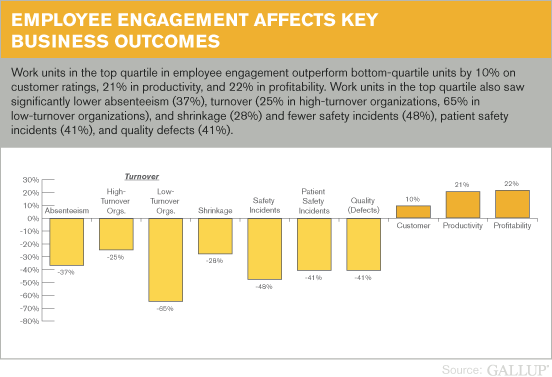With every webpage loaded, email sent, or video streamed, network traffic takes a complex journey…
Wondering what the best way for employees to work more efficiently is?
According to a Gallup poll, an engaged and productive workforce can increase corporate profits by as much as 21%. With the talent competition only increasing, every company’s IT and business leaders need to consider implementing workplace productivity strategies.
In this article, we share tips for optimizing productivity levels for a modern workforce and exploring new ways of measuring it daily.
What Is Workplace Productivity
Workplace productivity is the degree to which employees can produce goods and services promptly and effectively. Improving workplace productivity can significantly affect employee satisfaction, company profitability, and national economies.

Why Workplace Productivity Matters
“Work smarter, not harder” is a famous phrase by Allen F. Morgenstern in the 1930s and the cornerstone of many prosperous enterprises. Innovative work in business entails raising output without raising costs.
Let’s take an example: increasing inputs in business to earn more revenue will only increase the production cost of your product. But precisely finding loopholes in your business and filling them will cost almost nothing and help you achieve profitability goals.
According to the US bureau of labor statistics, high productivity growth in the US business sector has produced nine times more output.
These figures demonstrate how modifying your method of operation can boost your company’s economic performance.
Benefits of Workplace Productivity
Workplace productivity’s importance is not limited to business revenue; it has a lot more to offer.
1. Improved Communication
Improved employee communication leads to better cohesion, team synergy, and workflows – ultimately leading to greater efficiency throughout the business.
2. Increased Efficiency and Output
Productivity is essential for businesses to remain competitive—increased efficiency results in increased output and ultimately surging revenue and profits.
3. Reduced Costs
Businesses typically suffer from high costs associated with inefficient processes and operations, such as wasted time and money on unnecessary staff or equipment purchases. By working more productively, businesses can significantly reduce these costs.

How to Improve Productivity in the Workplace
It’s impossible for humans to be motivated and enthusiastic all the time. However, some techniques can help your employees be self-driven during work hours.
1. Set Clear and Achievable Goals
Employees need to have a clear goal in mind to achieve targets. Suppose employees know what they need to do and why; they will be more likely to expend the effort necessary to achieve those goals. Therefore, it’s essential that staff members fully comprehend the tasks they are working on.
Here, communication and setting attainable goals play a crucial role.
According to a study by the American Institute of Stress, unachievable work goals may pressure employees, stressing out 41% of workers at their jobs.
By improving communication within the office, managers can ensure that everyone is on the same page and that completion of tasks happens efficiently.
2. Use Productivity-Enhancing Techniques
There are several tried and tested ways that work best to improve productivity. Following them will provide your workers with a positive working experience.
According to a Gartner 2021 poll on digital work, 43% of the workers believe flexible working hours allowed them to accomplish their productivity goals. Moreover, you can follow a 90-minute cycle technique and give your workers a break every 90 minutes. Such methods provide a positive work experience without getting burned out.

3. Provide Additional Benefits to Employees
Employees who are consistently productive in the workplace often expect great perks. Hence, rewarding your employees with additional benefits like paid trip plans, tuition reimbursement, bonuses, etc., to increase productivity in your workplace to keep your employees motivated to work harder.
Employee well-being programs can also help in this way. These programs not only attract the best talent in the market but also give your current employees the satisfaction of a secure future. According to research in the USA, about 75% of employees agree that the well-being programs offered by their owners are why they continue their job.
But if you just started up, and can’t afford these programs, acknowledging your employees at the end of the week can make all the difference.
There are numerous ways to reward employees without seeming forced or phony, so find one that works best for your workplace and your team.
4. Use Digital Experience Monitoring (DEM) Tools
Are there any old, inefficient methods that your employees use to complete tasks? If yes, this might account for your sluggish performance in business.
According to research, 67% of digital workers feel that having critical information from all their apps accessible in one place would simplify their work life.
Since there is a direct impact on profitability and employee satisfaction, employers and business leaders need to consider using collaboration tools to foster a dynamic work environment. What follows is a lasting impact on workplace culture and employees’ digital experience. Unfortunately, according to Gartner, only 13% of employees perform satisfactorily in their digital workplace environment.
The better the quality of tools, the more productive the employees are. When knowledge workers use enterprise SaaS apps such as Microsoft 365 (Teams, Outlook), Salesforce, Zoom, and more, they expect a seamless digital experience with minimal disruptions.
Digital Experience Monitoring tools reduce IT hassles by gathering and measuring employees’ experience with digital apps using endpoint and SaaS monitoring features in real-time. As a result, your team can quickly identify and resolve errors in any network, device, or application. By investing in DEM and Digital Employee Experience (DEX) systems, IT and business create a positive impact when it comes to retaining the best talent and opening up more possibilities for greater productivity.
Achieve More in Less Time With DEM
Employee digital experience matters.
Whether your business operates in hybrid mode or not, Exoprise offers a Digital Experience Monitoring (DEM) solution with a complete app and network visibility using proactive synthetics and real user monitoring (RUM) coverage.
Technology teams can troubleshoot application, and network performance issues 24*7 from any location and deliver a far-reaching digital experience to boost workplace productivity.
That’s the power of our Service Watch DEM solution that IT can rely upon.
Request a demo today with our sales team and see what it can do for your business.


